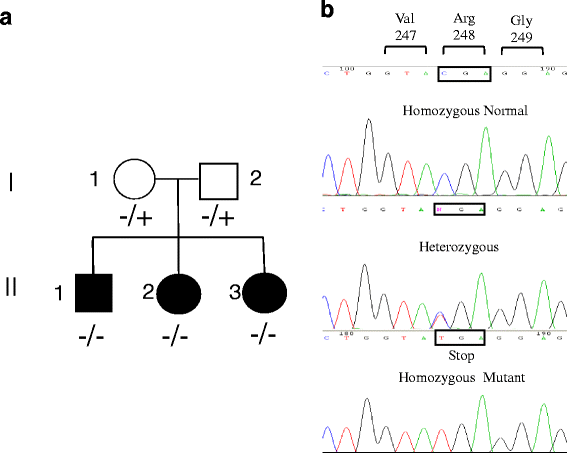Invasive meningococcal disease in three siblings with hereditary deficiency of the 8(th) component of complement: evidence for the importance of an early diagnosis
- PMID: 27183977
- PMCID: PMC4869260
- DOI: 10.1186/s13023-016-0448-5
Invasive meningococcal disease in three siblings with hereditary deficiency of the 8(th) component of complement: evidence for the importance of an early diagnosis
Abstract
Background: Deficiency of the eighth component of complement (C8) is a very rare primary immunodeficiency, associated with invasive, recurrent infections mainly caused by Neisseria species. We report functional and immunochemical C8 deficiency diagnosed in three Albanian siblings who presented with severe meningococcal infections at the age of 15 years, 4 years and 17 months, respectively. The youngest suffered serious complications (necrosis of fingers and toes requiring amputation).
Methods: Functional activity of the classical, alternative and mannose-binding lectin complement pathways was measured in serum from the 3 siblings and their parents (37-year-old woman and 42-year-old man). Forty healthy subjects (20 males and 20 females aged 4-38 years) served as normal controls. Serum complement factors were measured by haemolytic assays and immunoblotting. Sequence DNA analysis of the C8B gene was performed.
Results: Analyses of the three complement pathways revealed no haemolytic activity and also absence of C8beta in serum samples from all three siblings. The genetic analysis showed that the three siblings were homozygous for the p.Arg428* mutation in the C8B gene on chromosome 1p32 (MIM 120960). The parents were heterozygous for the mutation and presented normal complement activities. A 2-year follow-up revealed no further infective episodes in the siblings after antibiotic prophylaxis and meningococcal vaccination.
Conclusions: Complement deficiencies are rare and their occurrence is often underestimated. In presence of invasive meningococcal infection, we highlight the importance of complement screening in patients and their relatives in order to discover any genetic defects which would render necessary prophylaxis to prevent recurrent infections and severe complications.
Keywords: C8 deficiency; Complement deficiency; Meningococcal disease; Neisseria meningitidis.
Figures


Similar articles
-
Hereditary complement deficiency in survivors of meningococcal disease: high prevalence of C7/C8 deficiency in Sephardic (Moroccan) Jews.Q J Med. 1987 Apr;63(240):349-58. Q J Med. 1987. PMID: 3685247
-
The role of complement in anti-bacterial defence.Ann Ital Med Int. 1994 Jul-Sep;9(3):173-7. Ann Ital Med Int. 1994. PMID: 7946895 Clinical Trial.
-
Molecular, genetic, and functional analysis of homozygous C8 beta-chain deficiency in two siblings.Immunopharmacology. 1997 Dec;38(1-2):215-21. doi: 10.1016/s0162-3109(97)00074-x. Immunopharmacology. 1997. PMID: 9476133
-
Deficiency of the eighth component of complement associated with recurrent meningococcal meningitis--case report and literature review.Braz J Infect Dis. 2004 Aug;8(4):328-30. doi: 10.1590/s1413-86702004000400010. Epub 2004 Nov 19. Braz J Infect Dis. 2004. PMID: 15565265 Review.
-
Complement deficiency states and infection: epidemiology, pathogenesis and consequences of neisserial and other infections in an immune deficiency.Medicine (Baltimore). 1984 Sep;63(5):243-73. Medicine (Baltimore). 1984. PMID: 6433145 Review.
Cited by
-
C8B in Complement and Coagulation Cascades Signaling Pathway is a predictor for Survival in HBV-Related Hepatocellular Carcinoma Patients.Cancer Manag Res. 2021 Apr 22;13:3503-3515. doi: 10.2147/CMAR.S302917. eCollection 2021. Cancer Manag Res. 2021. PMID: 33911900 Free PMC article.
-
The Complement System.Adv Exp Med Biol. 2025;1476:147-198. doi: 10.1007/978-3-031-85340-1_7. Adv Exp Med Biol. 2025. PMID: 40622543 Review.
-
Enrichment of Immune Dysregulation Disorders in Adult Patients with Human Inborn Errors of Immunity.J Clin Immunol. 2024 Feb 16;44(3):61. doi: 10.1007/s10875-024-01664-2. J Clin Immunol. 2024. PMID: 38363452 Free PMC article.
-
Hereditary Deficiency of the Second Component of Complement: Early Diagnosis and 21-Year Follow-Up of a Family.Medicina (Kaunas). 2020 Mar 10;56(3):120. doi: 10.3390/medicina56030120. Medicina (Kaunas). 2020. PMID: 32164349 Free PMC article.
-
Update on the human and mouse lipocalin (LCN) gene family, including evidence the mouse Mup cluster is result of an "evolutionary bloom".Hum Genomics. 2019 Feb 19;13(1):11. doi: 10.1186/s40246-019-0191-9. Hum Genomics. 2019. PMID: 30782214 Free PMC article. Review.
References
-
- Modell V, Gee B, Lewis DB, Orange JS, Roifman CM, Routes JM, orensen RU, Notarangelo LD, Modell F. Global study of primary immunodeficiency diseases (PI) – diagnosis, treatment, and economic impact: an update report from the Jeffrey Modell Foundation. Immunol Res. 2011;51:61–70. - PubMed
-
- Turley AJ, Gathmann B, Bangs C, Bradbury M, Seneviratne S, Gonzalez-Granado LI, Hackett S, Kutukculer N, Alachkar H, Hambleton S, Ritterbusch H, Kralickova P, Marodi L, Seidel MG, Dueckers G, Roesler J, Huissoon A, Baxendale H, Litzman J, Arkwright PD. Spectrum and management of complement immunodeficiencies (excluding hereditary angioedema) across Europe. J Clin Immunol. 2015;35(2):199–205. doi: 10.1007/s10875-015-0137-5. - DOI - PubMed
MeSH terms
Substances
LinkOut - more resources
Full Text Sources
Other Literature Sources
Medical
Miscellaneous

